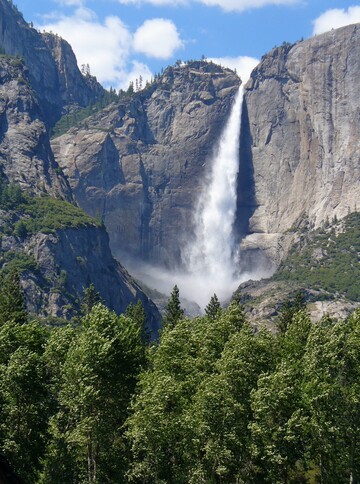What is the water cycle?

Waterfalls are an important part of the water cycle, as they help to move water from the Earth's surface to the atmosphere.

Waterfalls are an important part of the water cycle, as they help to move water from the Earth's surface to the atmosphere.
The water cycle is the continuous movement of water on, above, and below the Earth's surface.
Evaporation: The sun's heat causes water to evaporate from the Earth's surface. This means that the water turns into a gas called water vapor. Water vapor is invisible, but you can see it when it condenses on a cold surface, like a window pane.
Condensation: When water vapor cools, it condenses back into liquid water. This is how clouds are formed. Clouds are made up of tiny water droplets.
Precipitation: When clouds get too heavy, the water droplets fall to the ground as rain, snow, sleet, or hail.
Collection: The water that falls to the ground can collect in rivers, lakes, oceans, or underground. It can also be absorbed by plants and trees.
The water cycle is a very important process. It helps to distribute water around the Earth and to keep the Earth's temperature stable.
Here are some concrete examples of the water cycle:
- When you boil water, the water evaporates and turns into steam.
- When you see your breath on a cold day, that's water vapor that has condensed on the cold air.
- When it rains, the water that falls to the ground eventually makes its way back to the oceans through rivers, lakes, and underground aquifers.
The water cycle is a never-ending process. Water is constantly moving from one place to another. It's an amazing thing to think about!
Here are some concluding thoughts:
- The water cycle is a very important process that helps to keep the Earth's temperature stable and to distribute water around the planet.
- There are many different ways that water can evaporate, condense, and precipitate.
- The water cycle is a never-ending process that has been happening for billions of years.
What is the rock cycle?
The rock cycle is a process that shows how rocks on Earth can change over a long time. It's like a never-ending recycling system for rocks.
There are three main types of rocks: sedimentary, igneous, and metamorphic rocks. Imagine you have a chocolate bar. If you heat the chocolate bar and it becomes all melted, that's like when igneous rocks are formed from hot magma or lava.
Then, if you let the melted chocolate cool down and harden again, that's like when igneous rocks cool and solidify. But what happens if you break the chocolate bar into small pieces and press them together to make a new shape? That's like when sedimentary rocks are formed from bits of other rocks or even shells and bones pressed together.
And finally, what if you take that new shape and heat it up a little? It might change its texture and appearance, just like when metamorphic rocks are formed from other rocks that are changed by heat and pressure. So, rocks can go through these different processes and change from one type to another, over and over again. It's a super cool cycle that happens deep within the Earth!
What is the water cycle and how do systems interact in this cycle?
The water cycle is like a big adventure that water goes on! It starts when the Sun shines its bright and warm rays onto the Earth. The Sun's heat makes the water from oceans, rivers, lakes, and even puddles turn into tiny, invisible water vapor. It's just like when water disappears from a wet towel when we hang it out to dry and the Sun helps it evaporate.
Then, these tiny water vapor molecules float up into the sky, where it's cooler. Up there, the water vapor becomes cooler too, and it turns back into little water droplets. Those droplets come together and form clouds, just like the fluffy ones you see in the sky. Have you ever seen a cloud that looks like a big, fluffy cotton candy? It's made of these water droplets! But clouds can't hold the water forever.
When they get really big and heavy, the water droplets fall from the sky as rain, snow, sleet, or hail. Just like jumping into a pool on a hot day, the water returns to the Earth!
When the rain falls, some of the water soaks into the ground and helps plants and trees grow. This is called infiltration. Other water flows into rivers, which eventually lead to the ocean. The water can also collect in lakes or stay on the Earth's surface as puddles. The cool thing is that some of the water that soaks into the ground can become underground water, which is stored in spaces between rocks. It's like when you dig a hole in the sand at the beach and it gets filled with water. This underground water is important because it can become a source of drinking water for people and animals and can also make springs or come back up as a fountain! And then the whole water adventure starts over again with the Sun's heat evaporating the water once more. It's like a big, watery circle that never ends!

Waterfalls are an important part of the water cycle, as they help to move water from the Earth's surface to the atmosphere.